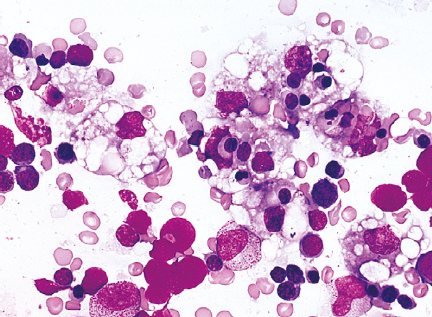Lymphoma
Content of This Page
1- Introduction
2- Causes
3- Symptoms
4- Stages of The Disease
5- Common Site of Lymphoma
6- Treatment
Introduction
Lymphoma is a type of cancer that begins in the lymphatic system, which is part of the body’s immune system. It primarily affects lymph nodes, spleen, and other lymphatic tissues. The disease involves abnormal growth of lymphocytes, a type of white blood cell. Symptoms can include swollen lymph nodes, fever, weight loss, and night sweats. Treatment often involves chemotherapy, radiation therapy, targeted therapy, or sometimes stem cell transplants, depending on the type and stage of lymphoma.

Causes
Genetic Mutations:
- Abnormalities in the DNA of lymphocytes can lead to lymphoma.
Immune System Disorders:
- Conditions like autoimmune diseases or immunodeficiency disorders may increase the risk.
Infections:
- Certain viral infections, such as Epstein-Barr virus (EBV) and human immunodeficiency virus (HIV), are linked to a higher risk of developing lymphoma.
Family History:
- Having a family history of lymphoma or other cancers may slightly increase the risk.
Age:
- Risk increases with age, though lymphoma can occur at any age.
Gender:
- Some types of lymphoma are more common in men than women.
Exposure to Chemicals:
- Long-term exposure to certain chemicals or pesticides might be associated with an increased risk.
Radiation Exposure:
- Previous radiation therapy for other cancers can increase the risk of lymphoma.
Symptoms
Swollen Lymph Nodes:
- Painless lumps or swelling in the neck, armpits, or groin.
Unexplained Weight Loss:
- Significant loss of weight without a known reason.
Fever:
- Persistent or recurring fever without an obvious cause.
Night Sweats:
- Profuse sweating during the night that can soak through clothing and bedding.
Fatigue:
- Persistent feeling of tiredness or weakness not relieved by rest.
Itchy Skin:
- Persistent itching, sometimes without a rash.
Abdominal Pain or Swelling:
- Pain or swelling in the abdomen due to enlarged lymph nodes or spleen.
Cough or Shortness of Breath:
- If lymphoma affects the chest area, it may cause respiratory symptoms.
Loss of Appetite:
- Decreased desire to eat, leading to weight loss and nutritional deficiencies.

Stages of The Disease
Stage I:
- Localized Disease: Cancer is found in a single lymph node or a single lymphoid organ (e.g., spleen).
Stage II:
- Regional Spread: Cancer is in two or more lymph nodes on the same side of the diaphragm, or it is in one lymph node region and nearby organ(s).
Stage III:
- Cross-Diaphragm Spread: Cancer is in lymph nodes on both sides of the diaphragm, or in lymph nodes and the spleen.
Stage IV:
- Advanced Disease: Cancer has spread to one or more organs outside the lymphatic system, such as the liver, bone marrow, or lungs.
-Additionally, each stage can be classified with an A or B designation:
- A: No significant symptoms.
- B: Symptoms such as weight loss, fever, or night sweats are present.
Common Sites of Lymphoma
- Cervical Lymph Nodes – Located in the neck.
- Axillary Lymph Nodes – Located in the armpits.
- Inguinal Lymph Nodes – Located in the groin area.
- Mediastinal Lymph Nodes – Located in the central chest area between the lungs.
- Spleen – Located in the upper left abdomen.
- Bone Marrow – Located within bones.
- Gastrointestinal Tract – Includes the stomach, intestines, and sometimes the esophagus.
- Liver – Located in the upper right abdomen.
- Skin – Can present as rashes or nodules on the skin.
- Central Nervous System – Includes the brain and spinal cord.
- Nasal Passages – Includes the area behind the nose.
- Sinuses – Air-filled spaces around the nose.
- Salivary Glands – Located near the mouth.
- Testes – Male reproductive organs.
- Ovaries – Female reproductive organs.
Treatment
Chemotherapy:
- Uses drugs to kill cancer cells or stop their growth, often administered in cycles.
Radiation Therapy:
- Uses high-energy rays to target and destroy cancer cells in specific areas, usually for localized lymphoma.
Targeted Therapy:
- Drugs that target specific molecules involved in lymphoma cell growth and survival.
Immunotherapy:
- Boosts the body’s immune system to recognize and attack lymphoma cells, including monoclonal antibodies and CAR T-cell therapy.
Stem Cell Transplant (Bone Marrow Transplant):
- Replaces damaged or destroyed bone marrow with healthy stem cells, often after high-dose chemotherapy.
Surgery:
- May be used to remove a tumor or affected lymph nodes, typically for localized disease.
Supportive Care:
- Manages symptoms and side effects, including pain management and nutritional support.
Clinical Trials:
- Offers access to new and experimental treatments that are being tested for efficacy and safety.